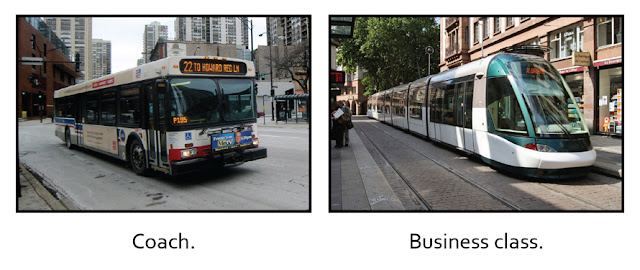Exit the #11
I heard Forrest Claypool speak at City Club this week, and
he did a good job of explaining the difficult and ultimately successful task of
reprioritizing, getting labor concessions, and making service cuts to balance
the CTA’s budget. One of those cuts was the #11 bus through Lincoln Park, and
it’s making a lot of people angry. Still, on the whole, it’s an impressive
achievement.
Seventy years ago, transit agencies decided buses are better
than streetcars because the routes can be added, discontinued, or redrawn at
any time. Buses are flexible. That’s a big advantage for a transit agency
that’s trying to balance its budget in the face of changing demographic trends
like urban divestment, suburban sprawl, white flight, and so forth. It’s not
the CTA’s job to make the city a better place to live, to help it attract
people from the suburbs, or outcompete other cities. The CTA is just supposed
to take people where they want to go.
If cancelling the #11 bus means a steep decline in foot
traffic on Lincoln Avenue, and businesses fail up and down the street, that’s
not the CTA’s fault. If you’re too young or too old to drive, or just too
sensible to spend $12,000 a year on a car (the average in Chicago), you’ll have
to walk to the L—but that’s not the CTA’s fault. And if Lincoln Avenue becomes
a place to drive through instead of a place to live, and that spoils the
quality of life and causes property values in the neighborhood to decline,
that’s not the CTA’s fault either.
I know Forrest Claypool cares about repopulating the vacated
parts of our city and making Chicago easier to get around in. I know he wants
to grow the economy and reduce traffic congestion. I know he cares about
helping Chicagoans reduce their household debt, waste less on driving, and
invest more in real estate or their kids’ education. I know he wants us to be
able to take transit to work so we don’t have to spend two or three hours of
every workday working to pay for the car that got us there. I know he wants to
fix all that. He just needs more tools in the toolbox.
Enter the Streetcar
Cities all over the United States are either building or
planning modern streetcar lines. For the most part, they’re not transit
projects—other cities don’t have the kind of population density and transit
ridership we do in Chicago to make their streetcars cost-effective as transit
systems. Instead, American streetcars are usually business and property
development initiatives. Everywhere they go in, they increase property values
and boost local business. They spark economic growth and urban revitalization.
Why? Because the public commitment to building streetcar
infrastructure—to putting tracks in the street—mitigates the risk for
developers and investors. It ensures that the location will retain its value
regardless of gas prices and recessions. It’s a promise of lasting convenience
and walkability for businesses and homeowners alike. That spurs and channels
growth all along the streetcar line.
For the CTA, the big advantage of the bus is flexibility.
But you don’t want flexibility if you just signed a fifteen-year lease. You
don’t want flexibility if you just bought a big apartment, thinking you could
afford it because you weren’t going to have to own, maintain, insure, fuel, and
park a car. You don’t want flexibility if you’re thinking of investing in a new
mixed-use transit-oriented development. The homeowner doesn’t want flexibility,
the developer doesn’t want flexibility, and the banker doesn’t want flexibility.
Everybody engaged in building up a neighborhood, in making it more vibrant and
convenient and fun to live in, wants reliability. Predictability.
Commitment.
The streetcar is not just about taking people where they
want to go, it’s about building strong, enduring neighborhoods.










